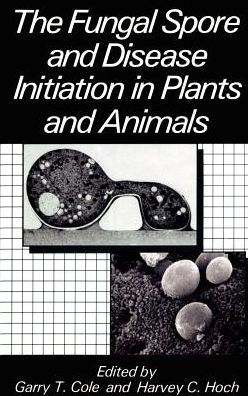The Fungal Spore and Disease Initiation in Plants and Animals
This treatise is focused on early aspects of fungal pathogenesis in plant and animal hosts. Our aim in choosing the topics and contributors was to demonstrate common approaches to studies of fungal-plant and fungal-animal interactions, particularly at the biochemical and molecular Ievels. For example, the initial events of adh«sion of fungal spores to the exposed surface tissues of the host are essential for subsequent invasion of the plant or animal and establishment of pathogenesis. A point of consensus among investigators who have directed their attention to such events in plants, insects, and vertebrates isthat spore adhesion to the host cuticle or epithelium is more than a simple binding event. lt is a complex and potentially pivotal process in fungal-plant interactions which "may involve the secretion of ftuids that prepare the infection court for the development of morphological stages of the germling" and subsequent invasion of the host (Nicholson and Epstein, Chapter 1). The attachment of the fungal propagule to the arthropod cuticle is also "mediated by the chemical components present on the outer layer of the spore wall and the epicuticle . . . . Initial attachment may be reinforced further by either the active secretion of adhesive materials or the modification of spore wall materiallocated at the [fungal spore arthropod] cuticle interface (Boucias and Pendland, Chapter 5).
1101511332
The Fungal Spore and Disease Initiation in Plants and Animals
This treatise is focused on early aspects of fungal pathogenesis in plant and animal hosts. Our aim in choosing the topics and contributors was to demonstrate common approaches to studies of fungal-plant and fungal-animal interactions, particularly at the biochemical and molecular Ievels. For example, the initial events of adh«sion of fungal spores to the exposed surface tissues of the host are essential for subsequent invasion of the plant or animal and establishment of pathogenesis. A point of consensus among investigators who have directed their attention to such events in plants, insects, and vertebrates isthat spore adhesion to the host cuticle or epithelium is more than a simple binding event. lt is a complex and potentially pivotal process in fungal-plant interactions which "may involve the secretion of ftuids that prepare the infection court for the development of morphological stages of the germling" and subsequent invasion of the host (Nicholson and Epstein, Chapter 1). The attachment of the fungal propagule to the arthropod cuticle is also "mediated by the chemical components present on the outer layer of the spore wall and the epicuticle . . . . Initial attachment may be reinforced further by either the active secretion of adhesive materials or the modification of spore wall materiallocated at the [fungal spore arthropod] cuticle interface (Boucias and Pendland, Chapter 5).
219.99
Out Of Stock
5
1

The Fungal Spore and Disease Initiation in Plants and Animals
555
The Fungal Spore and Disease Initiation in Plants and Animals
555Related collections and offers
219.99
Out Of Stock

Product Details
| ISBN-13: | 9780306434549 |
|---|---|
| Publisher: | Springer US |
| Publication date: | 02/28/1991 |
| Edition description: | 1991 |
| Pages: | 555 |
| Product dimensions: | 6.14(w) x 9.21(h) x 0.36(d) |
From the B&N Reads Blog
